Comprehensive Report: Historical Cost and Social Accounting Principles
VerifiedAdded on 2020/03/02
|9
|1566
|73
Report
AI Summary
This report delves into the principles of historical cost and social accounting. It begins by defining historical cost, emphasizing its reliance on past events and consistency, and its role in asset valuation and stewardship. The report then discusses the advantages and disadvantages of historical cost, including valuation issues and its impact on financial statements. It proceeds to define social accounting, its various types, and the importance of environmental issues and corporate social responsibility (CSR). The role of government in regulating environmental issues and factors leading to the emergence of CSR practices are also explored. The report concludes by explaining financial and physical capital maintenance concepts, highlighting their significance in maintaining a company's financial health and operational capacity. References to relevant literature are also provided.
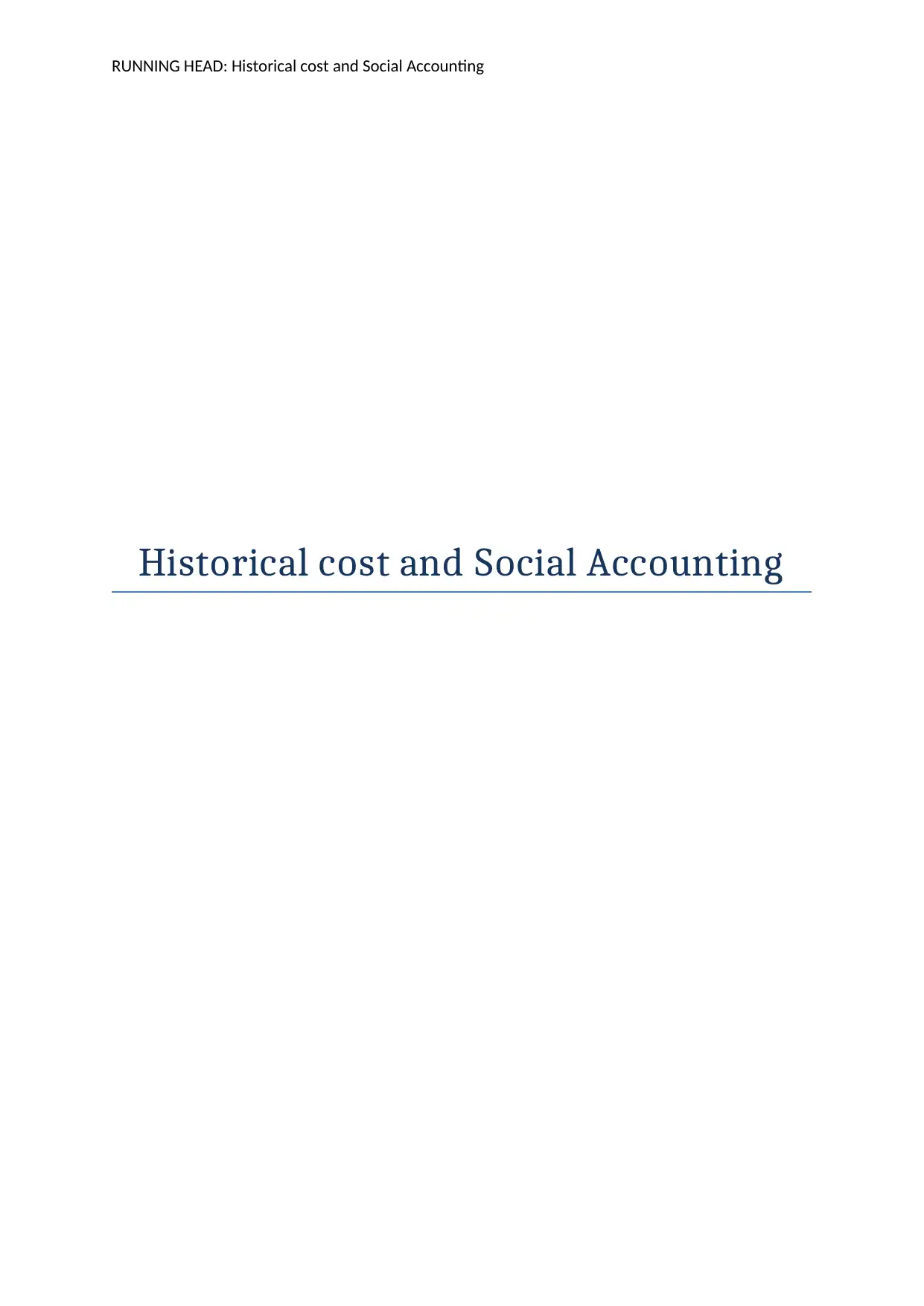
RUNNING HEAD: Historical cost and Social Accounting
Historical cost and Social Accounting
Historical cost and Social Accounting
Paraphrase This Document
Need a fresh take? Get an instant paraphrase of this document with our AI Paraphraser
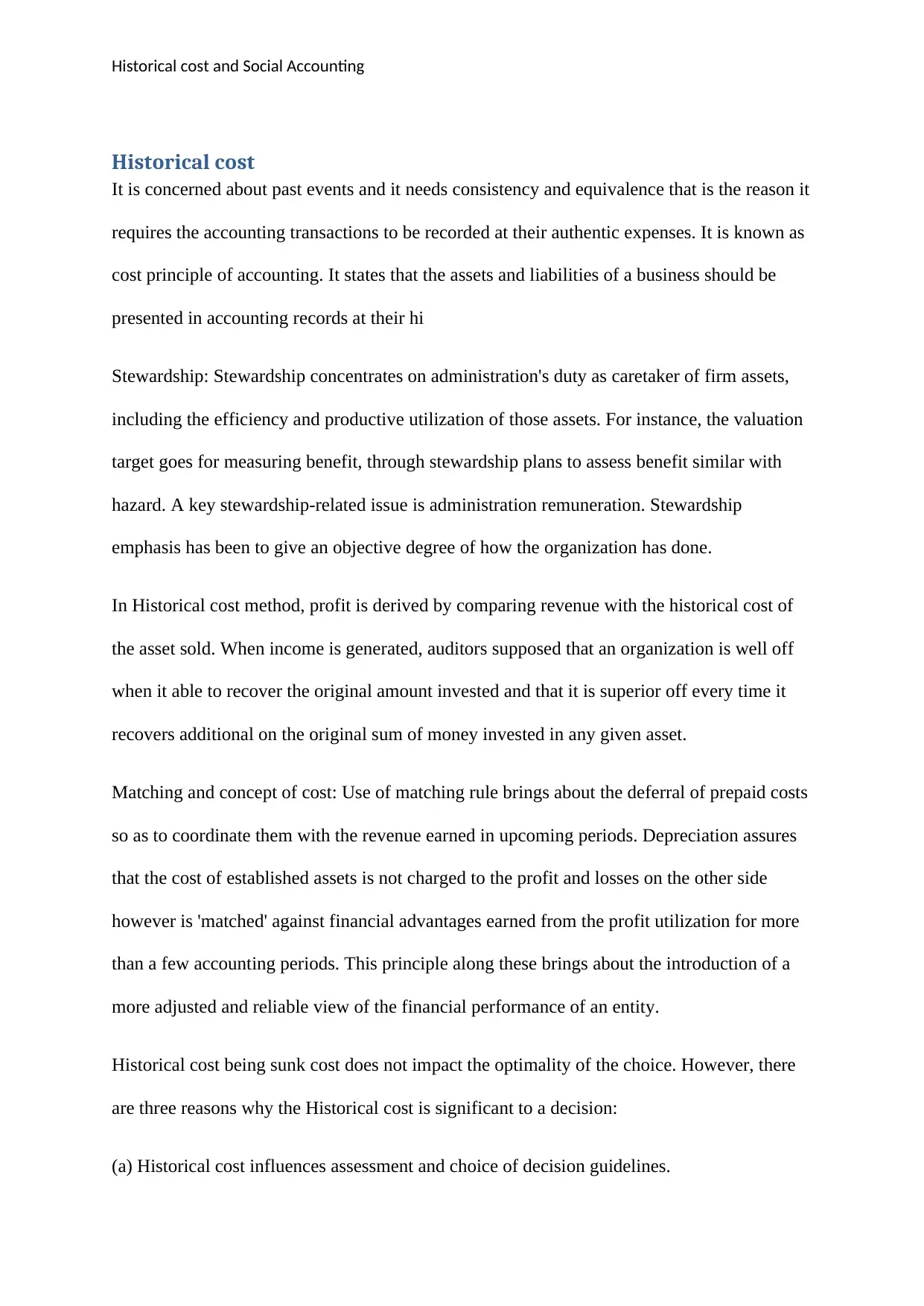
Historical cost and Social Accounting
Historical cost
It is concerned about past events and it needs consistency and equivalence that is the reason it
requires the accounting transactions to be recorded at their authentic expenses. It is known as
cost principle of accounting. It states that the assets and liabilities of a business should be
presented in accounting records at their hi
Stewardship: Stewardship concentrates on administration's duty as caretaker of firm assets,
including the efficiency and productive utilization of those assets. For instance, the valuation
target goes for measuring benefit, through stewardship plans to assess benefit similar with
hazard. A key stewardship-related issue is administration remuneration. Stewardship
emphasis has been to give an objective degree of how the organization has done.
In Historical cost method, profit is derived by comparing revenue with the historical cost of
the asset sold. When income is generated, auditors supposed that an organization is well off
when it able to recover the original amount invested and that it is superior off every time it
recovers additional on the original sum of money invested in any given asset.
Matching and concept of cost: Use of matching rule brings about the deferral of prepaid costs
so as to coordinate them with the revenue earned in upcoming periods. Depreciation assures
that the cost of established assets is not charged to the profit and losses on the other side
however is 'matched' against financial advantages earned from the profit utilization for more
than a few accounting periods. This principle along these brings about the introduction of a
more adjusted and reliable view of the financial performance of an entity.
Historical cost being sunk cost does not impact the optimality of the choice. However, there
are three reasons why the Historical cost is significant to a decision:
(а) Historical cost influences assessment and choice of decision guidelines.
Historical cost
It is concerned about past events and it needs consistency and equivalence that is the reason it
requires the accounting transactions to be recorded at their authentic expenses. It is known as
cost principle of accounting. It states that the assets and liabilities of a business should be
presented in accounting records at their hi
Stewardship: Stewardship concentrates on administration's duty as caretaker of firm assets,
including the efficiency and productive utilization of those assets. For instance, the valuation
target goes for measuring benefit, through stewardship plans to assess benefit similar with
hazard. A key stewardship-related issue is administration remuneration. Stewardship
emphasis has been to give an objective degree of how the organization has done.
In Historical cost method, profit is derived by comparing revenue with the historical cost of
the asset sold. When income is generated, auditors supposed that an organization is well off
when it able to recover the original amount invested and that it is superior off every time it
recovers additional on the original sum of money invested in any given asset.
Matching and concept of cost: Use of matching rule brings about the deferral of prepaid costs
so as to coordinate them with the revenue earned in upcoming periods. Depreciation assures
that the cost of established assets is not charged to the profit and losses on the other side
however is 'matched' against financial advantages earned from the profit utilization for more
than a few accounting periods. This principle along these brings about the introduction of a
more adjusted and reliable view of the financial performance of an entity.
Historical cost being sunk cost does not impact the optimality of the choice. However, there
are three reasons why the Historical cost is significant to a decision:
(а) Historical cost influences assessment and choice of decision guidelines.
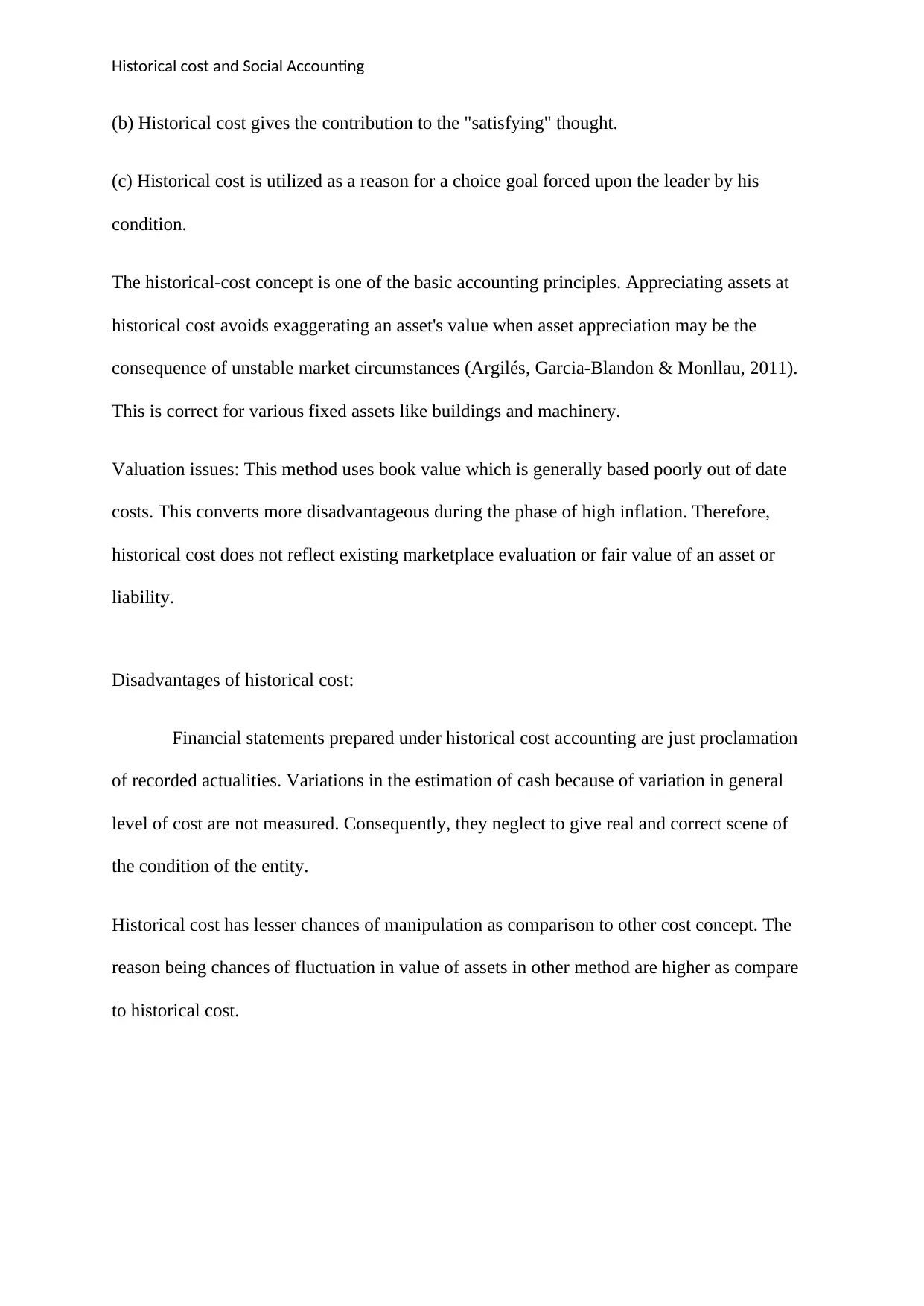
Historical cost and Social Accounting
(b) Historical cost gives the contribution to the "satisfying" thought.
(c) Historical cost is utilized as a reason for a choice goal forced upon the leader by his
condition.
The historical-cost concept is one of the basic accounting principles. Appreciating assets at
historical cost avoids exaggerating an asset's value when asset appreciation may be the
consequence of unstable market circumstances (Argilés, Garcia-Blandon & Monllau, 2011).
This is correct for various fixed assets like buildings and machinery.
Valuation issues: This method uses book value which is generally based poorly out of date
costs. This converts more disadvantageous during the phase of high inflation. Therefore,
historical cost does not reflect existing marketplace evaluation or fair value of an asset or
liability.
Disadvantages of historical cost:
Financial statements prepared under historical cost accounting are just proclamation
of recorded actualities. Variations in the estimation of cash because of variation in general
level of cost are not measured. Consequently, they neglect to give real and correct scene of
the condition of the entity.
Historical cost has lesser chances of manipulation as comparison to other cost concept. The
reason being chances of fluctuation in value of assets in other method are higher as compare
to historical cost.
(b) Historical cost gives the contribution to the "satisfying" thought.
(c) Historical cost is utilized as a reason for a choice goal forced upon the leader by his
condition.
The historical-cost concept is one of the basic accounting principles. Appreciating assets at
historical cost avoids exaggerating an asset's value when asset appreciation may be the
consequence of unstable market circumstances (Argilés, Garcia-Blandon & Monllau, 2011).
This is correct for various fixed assets like buildings and machinery.
Valuation issues: This method uses book value which is generally based poorly out of date
costs. This converts more disadvantageous during the phase of high inflation. Therefore,
historical cost does not reflect existing marketplace evaluation or fair value of an asset or
liability.
Disadvantages of historical cost:
Financial statements prepared under historical cost accounting are just proclamation
of recorded actualities. Variations in the estimation of cash because of variation in general
level of cost are not measured. Consequently, they neglect to give real and correct scene of
the condition of the entity.
Historical cost has lesser chances of manipulation as comparison to other cost concept. The
reason being chances of fluctuation in value of assets in other method are higher as compare
to historical cost.
⊘ This is a preview!⊘
Do you want full access?
Subscribe today to unlock all pages.

Trusted by 1+ million students worldwide
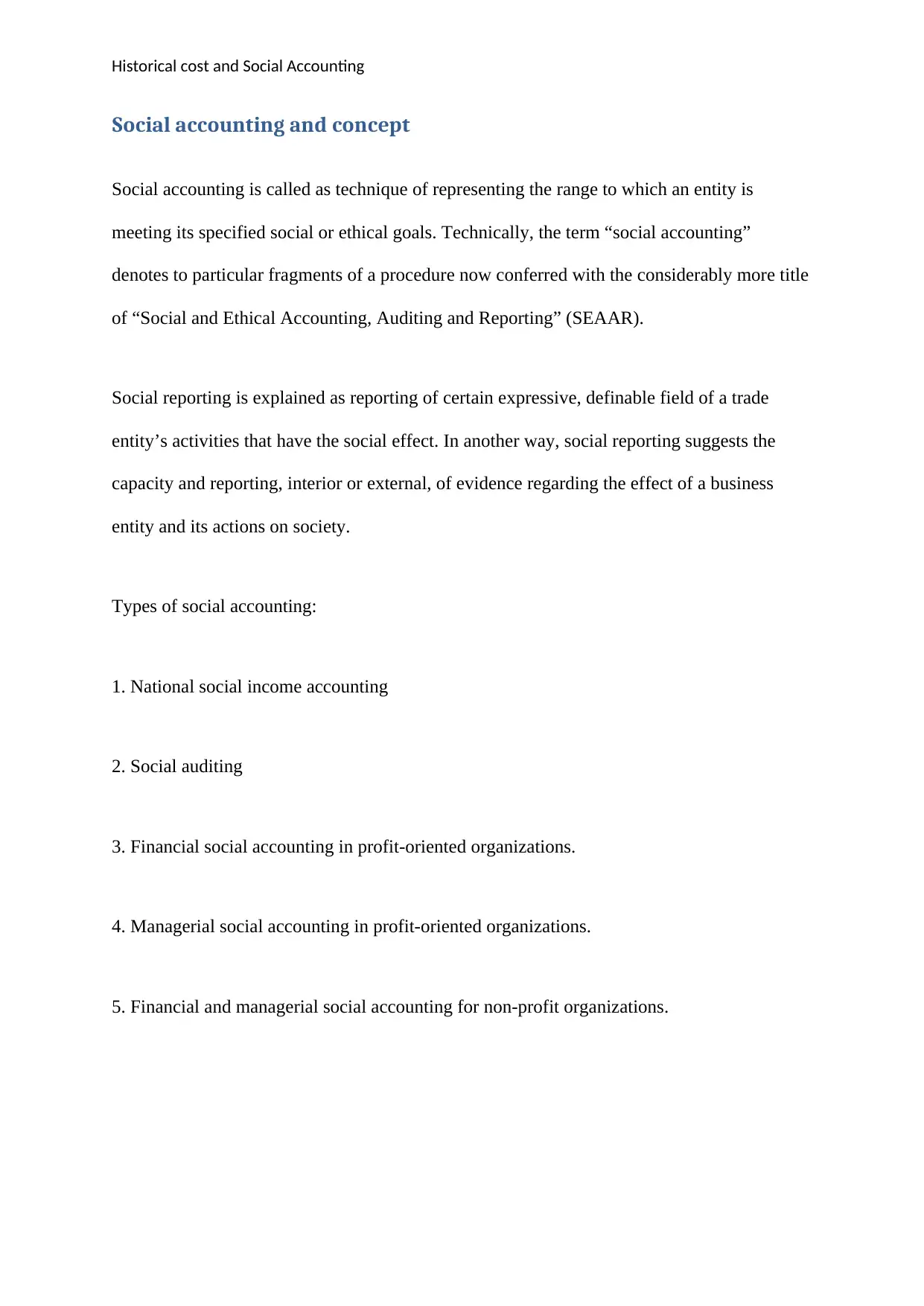
Historical cost and Social Accounting
Social accounting and concept
Social accounting is called as technique of representing the range to which an entity is
meeting its specified social or ethical goals. Technically, the term “social accounting”
denotes to particular fragments of a procedure now conferred with the considerably more title
of “Social and Ethical Accounting, Auditing and Reporting” (SEAAR).
Social reporting is explained as reporting of certain expressive, definable field of a trade
entity’s activities that have the social effect. In another way, social reporting suggests the
capacity and reporting, interior or external, of evidence regarding the effect of a business
entity and its actions on society.
Types of social accounting:
1. National social income accounting
2. Social auditing
3. Financial social accounting in profit-oriented organizations.
4. Managerial social accounting in profit-oriented organizations.
5. Financial and managerial social accounting for non-profit organizations.
Social accounting and concept
Social accounting is called as technique of representing the range to which an entity is
meeting its specified social or ethical goals. Technically, the term “social accounting”
denotes to particular fragments of a procedure now conferred with the considerably more title
of “Social and Ethical Accounting, Auditing and Reporting” (SEAAR).
Social reporting is explained as reporting of certain expressive, definable field of a trade
entity’s activities that have the social effect. In another way, social reporting suggests the
capacity and reporting, interior or external, of evidence regarding the effect of a business
entity and its actions on society.
Types of social accounting:
1. National social income accounting
2. Social auditing
3. Financial social accounting in profit-oriented organizations.
4. Managerial social accounting in profit-oriented organizations.
5. Financial and managerial social accounting for non-profit organizations.
Paraphrase This Document
Need a fresh take? Get an instant paraphrase of this document with our AI Paraphraser
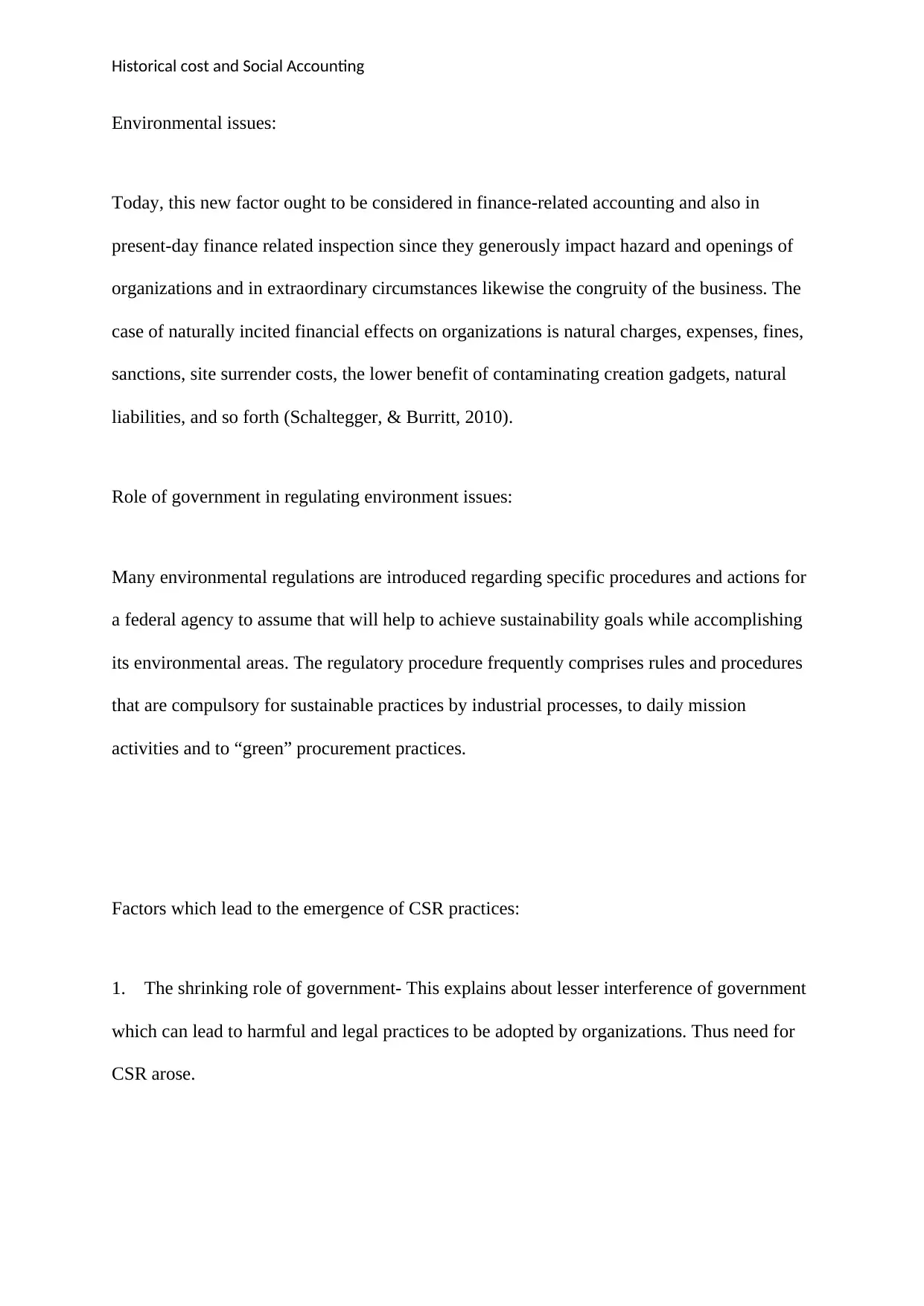
Historical cost and Social Accounting
Environmental issues:
Today, this new factor ought to be considered in finance-related accounting and also in
present-day finance related inspection since they generously impact hazard and openings of
organizations and in extraordinary circumstances likewise the congruity of the business. The
case of naturally incited financial effects on organizations is natural charges, expenses, fines,
sanctions, site surrender costs, the lower benefit of contaminating creation gadgets, natural
liabilities, and so forth (Schaltegger, & Burritt, 2010).
Role of government in regulating environment issues:
Many environmental regulations are introduced regarding specific procedures and actions for
a federal agency to assume that will help to achieve sustainability goals while accomplishing
its environmental areas. The regulatory procedure frequently comprises rules and procedures
that are compulsory for sustainable practices by industrial processes, to daily mission
activities and to “green” procurement practices.
Factors which lead to the emergence of CSR practices:
1. The shrinking role of government- This explains about lesser interference of government
which can lead to harmful and legal practices to be adopted by organizations. Thus need for
CSR arose.
Environmental issues:
Today, this new factor ought to be considered in finance-related accounting and also in
present-day finance related inspection since they generously impact hazard and openings of
organizations and in extraordinary circumstances likewise the congruity of the business. The
case of naturally incited financial effects on organizations is natural charges, expenses, fines,
sanctions, site surrender costs, the lower benefit of contaminating creation gadgets, natural
liabilities, and so forth (Schaltegger, & Burritt, 2010).
Role of government in regulating environment issues:
Many environmental regulations are introduced regarding specific procedures and actions for
a federal agency to assume that will help to achieve sustainability goals while accomplishing
its environmental areas. The regulatory procedure frequently comprises rules and procedures
that are compulsory for sustainable practices by industrial processes, to daily mission
activities and to “green” procurement practices.
Factors which lead to the emergence of CSR practices:
1. The shrinking role of government- This explains about lesser interference of government
which can lead to harmful and legal practices to be adopted by organizations. Thus need for
CSR arose.
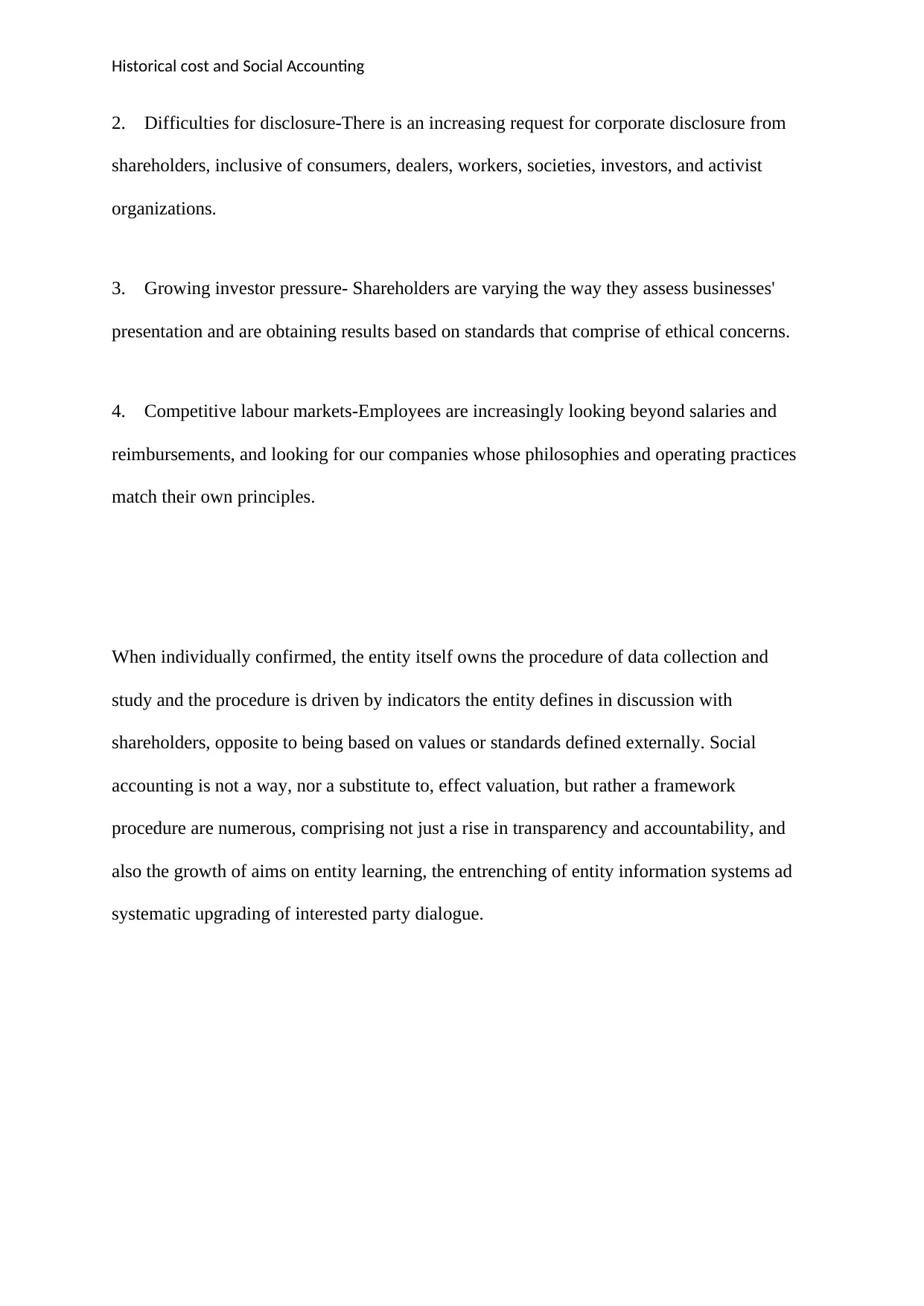
Historical cost and Social Accounting
2. Difficulties for disclosure-There is an increasing request for corporate disclosure from
shareholders, inclusive of consumers, dealers, workers, societies, investors, and activist
organizations.
3. Growing investor pressure- Shareholders are varying the way they assess businesses'
presentation and are obtaining results based on standards that comprise of ethical concerns.
4. Competitive labour markets-Employees are increasingly looking beyond salaries and
reimbursements, and looking for our companies whose philosophies and operating practices
match their own principles.
When individually confirmed, the entity itself owns the procedure of data collection and
study and the procedure is driven by indicators the entity defines in discussion with
shareholders, opposite to being based on values or standards defined externally. Social
accounting is not a way, nor a substitute to, effect valuation, but rather a framework
procedure are numerous, comprising not just a rise in transparency and accountability, and
also the growth of aims on entity learning, the entrenching of entity information systems ad
systematic upgrading of interested party dialogue.
2. Difficulties for disclosure-There is an increasing request for corporate disclosure from
shareholders, inclusive of consumers, dealers, workers, societies, investors, and activist
organizations.
3. Growing investor pressure- Shareholders are varying the way they assess businesses'
presentation and are obtaining results based on standards that comprise of ethical concerns.
4. Competitive labour markets-Employees are increasingly looking beyond salaries and
reimbursements, and looking for our companies whose philosophies and operating practices
match their own principles.
When individually confirmed, the entity itself owns the procedure of data collection and
study and the procedure is driven by indicators the entity defines in discussion with
shareholders, opposite to being based on values or standards defined externally. Social
accounting is not a way, nor a substitute to, effect valuation, but rather a framework
procedure are numerous, comprising not just a rise in transparency and accountability, and
also the growth of aims on entity learning, the entrenching of entity information systems ad
systematic upgrading of interested party dialogue.
⊘ This is a preview!⊘
Do you want full access?
Subscribe today to unlock all pages.

Trusted by 1+ million students worldwide
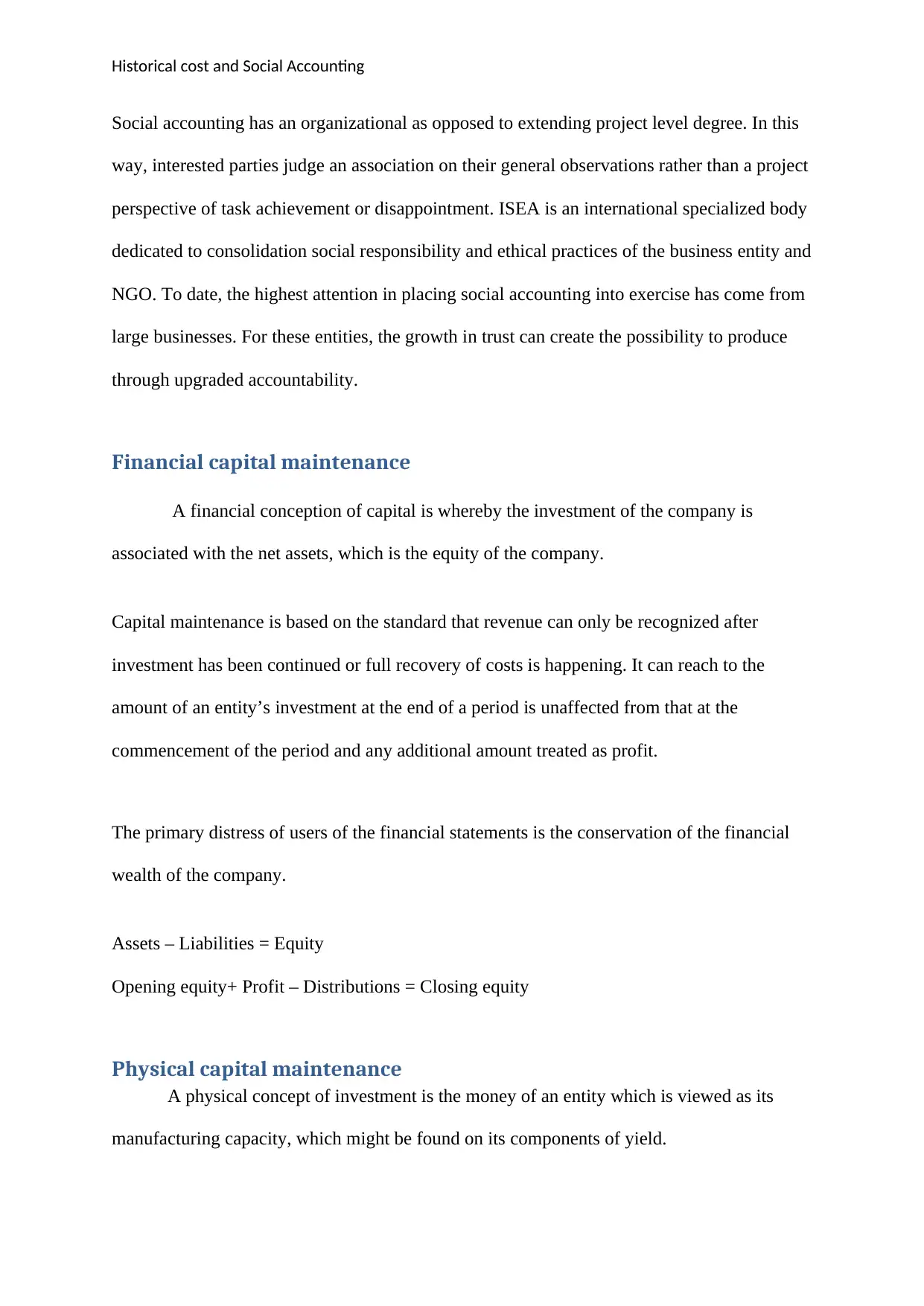
Historical cost and Social Accounting
Social accounting has an organizational as opposed to extending project level degree. In this
way, interested parties judge an association on their general observations rather than a project
perspective of task achievement or disappointment. ISEA is an international specialized body
dedicated to consolidation social responsibility and ethical practices of the business entity and
NGO. To date, the highest attention in placing social accounting into exercise has come from
large businesses. For these entities, the growth in trust can create the possibility to produce
through upgraded accountability.
Financial capital maintenance
A financial conception of capital is whereby the investment of the company is
associated with the net assets, which is the equity of the company.
Capital maintenance is based on the standard that revenue can only be recognized after
investment has been continued or full recovery of costs is happening. It can reach to the
amount of an entity’s investment at the end of a period is unaffected from that at the
commencement of the period and any additional amount treated as profit.
The primary distress of users of the financial statements is the conservation of the financial
wealth of the company.
Assets – Liabilities = Equity
Opening equity+ Profit – Distributions = Closing equity
Physical capital maintenance
A physical concept of investment is the money of an entity which is viewed as its
manufacturing capacity, which might be found on its components of yield.
Social accounting has an organizational as opposed to extending project level degree. In this
way, interested parties judge an association on their general observations rather than a project
perspective of task achievement or disappointment. ISEA is an international specialized body
dedicated to consolidation social responsibility and ethical practices of the business entity and
NGO. To date, the highest attention in placing social accounting into exercise has come from
large businesses. For these entities, the growth in trust can create the possibility to produce
through upgraded accountability.
Financial capital maintenance
A financial conception of capital is whereby the investment of the company is
associated with the net assets, which is the equity of the company.
Capital maintenance is based on the standard that revenue can only be recognized after
investment has been continued or full recovery of costs is happening. It can reach to the
amount of an entity’s investment at the end of a period is unaffected from that at the
commencement of the period and any additional amount treated as profit.
The primary distress of users of the financial statements is the conservation of the financial
wealth of the company.
Assets – Liabilities = Equity
Opening equity+ Profit – Distributions = Closing equity
Physical capital maintenance
A physical concept of investment is the money of an entity which is viewed as its
manufacturing capacity, which might be found on its components of yield.
Paraphrase This Document
Need a fresh take? Get an instant paraphrase of this document with our AI Paraphraser
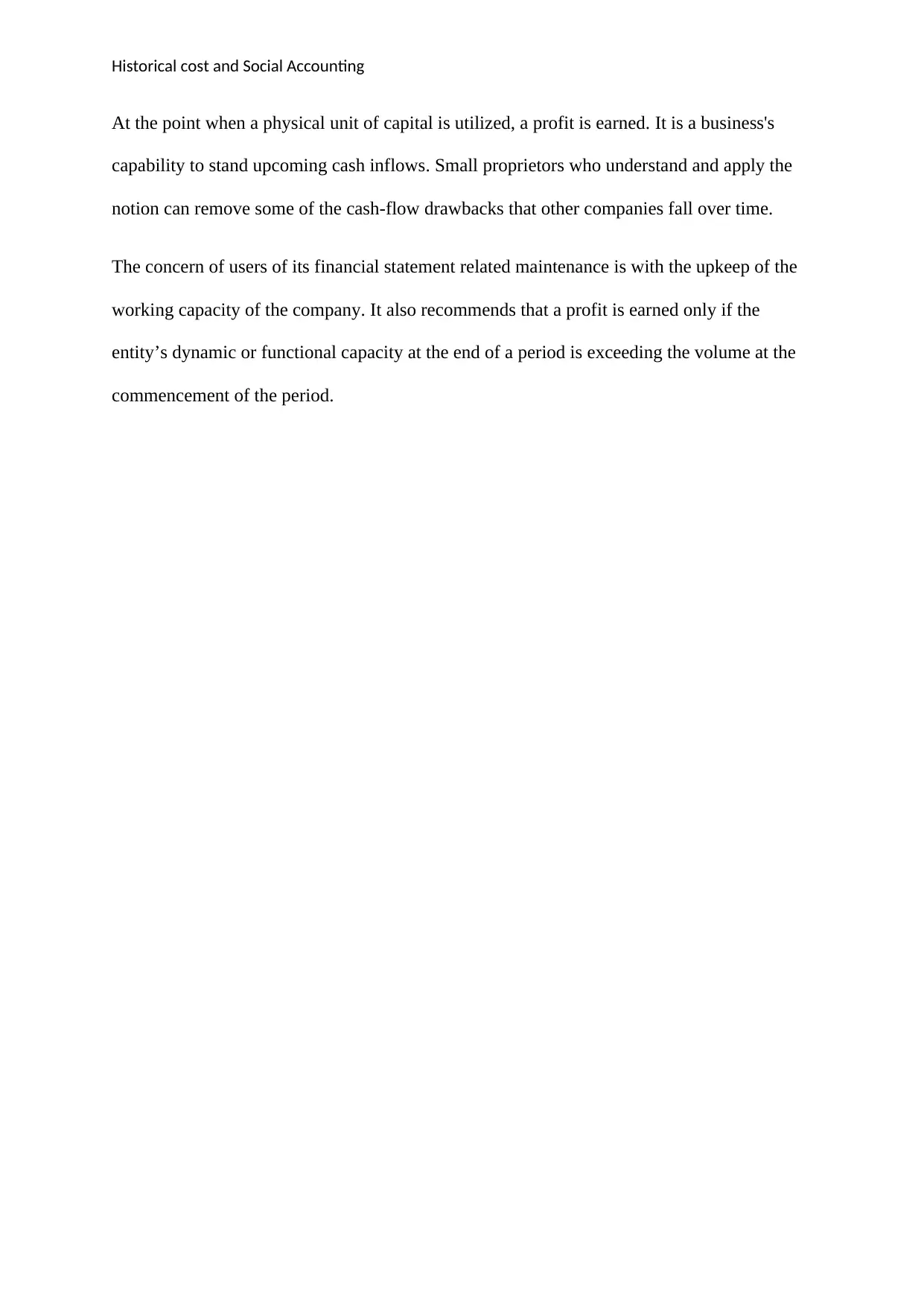
Historical cost and Social Accounting
At the point when a physical unit of capital is utilized, a profit is earned. It is a business's
capability to stand upcoming cash inflows. Small proprietors who understand and apply the
notion can remove some of the cash-flow drawbacks that other companies fall over time.
The concern of users of its financial statement related maintenance is with the upkeep of the
working capacity of the company. It also recommends that a profit is earned only if the
entity’s dynamic or functional capacity at the end of a period is exceeding the volume at the
commencement of the period.
At the point when a physical unit of capital is utilized, a profit is earned. It is a business's
capability to stand upcoming cash inflows. Small proprietors who understand and apply the
notion can remove some of the cash-flow drawbacks that other companies fall over time.
The concern of users of its financial statement related maintenance is with the upkeep of the
working capacity of the company. It also recommends that a profit is earned only if the
entity’s dynamic or functional capacity at the end of a period is exceeding the volume at the
commencement of the period.
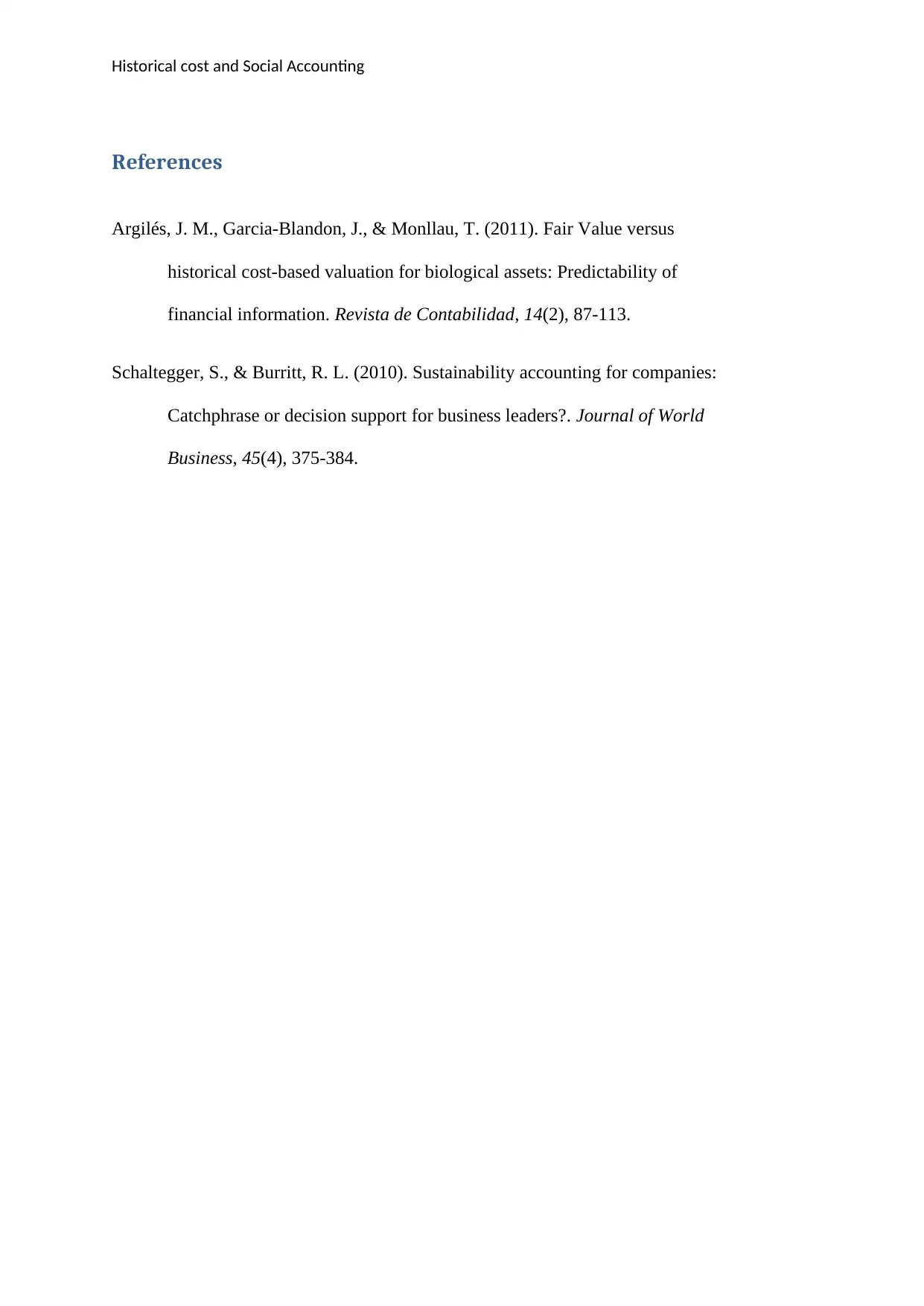
Historical cost and Social Accounting
References
Argilés, J. M., Garcia-Blandon, J., & Monllau, T. (2011). Fair Value versus
historical cost-based valuation for biological assets: Predictability of
financial information. Revista de Contabilidad, 14(2), 87-113.
Schaltegger, S., & Burritt, R. L. (2010). Sustainability accounting for companies:
Catchphrase or decision support for business leaders?. Journal of World
Business, 45(4), 375-384.
References
Argilés, J. M., Garcia-Blandon, J., & Monllau, T. (2011). Fair Value versus
historical cost-based valuation for biological assets: Predictability of
financial information. Revista de Contabilidad, 14(2), 87-113.
Schaltegger, S., & Burritt, R. L. (2010). Sustainability accounting for companies:
Catchphrase or decision support for business leaders?. Journal of World
Business, 45(4), 375-384.
⊘ This is a preview!⊘
Do you want full access?
Subscribe today to unlock all pages.

Trusted by 1+ million students worldwide
1 out of 9
Related Documents
Your All-in-One AI-Powered Toolkit for Academic Success.
+13062052269
info@desklib.com
Available 24*7 on WhatsApp / Email
![[object Object]](/_next/static/media/star-bottom.7253800d.svg)
Unlock your academic potential
Copyright © 2020–2025 A2Z Services. All Rights Reserved. Developed and managed by ZUCOL.





